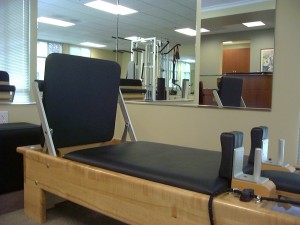Therapeutic exercise is a hallmark of physical therapy. Among many benefits, therapeutic exercise can restore correct strength ratios between muscles, increase functional capacity, and improve coordination.
When prescribing therapeutic exercise, the physical therapist must consider the entire sequence of neuromuscular events that allows the patient to perform their daily activities and sports. This sequence can be thought of as a chain composed of three elements: proximal (closest to the spine) stability, distal (away from the spine) motion, and finally, the desired fine motor skill.
While this sequence of neuromuscular events accompanies all deliberate human motion, it is perhaps most readily illustrated by the action of throwing a dart. The motion requires a firm basis of proximal support and slight rotation around the spine, distal motion performed by muscles of the chest, shoulder, and upper and lower arm, and fine motor skill as the fingers take control of the dart’s release. The controlled, simultaneous engagement of all three elements is what enables the competitor to hit the target’s triple ring.
In Pilates-speak, the deep muscles of the trunk that provide proximal stability are called the “core,” and the ability to move one’s limbs and carry out skilled tasks while holding the trunk steady is called “dissociation.” Strength and control over these deep muscles of your trunk provide the stable base required to perform tasks such as kicking a soccer ball or swinging a golf club.
Here at Physical Therapy of Los Gatos we draw from a wide a variety of exercises to help our patients coordinate, strengthen, and engage this three-part chain. Visitors to our clinic might recognize our use of movements from yoga, Swiss ball exercises, elastic band resistance exercises — even pull ups and hands stands. They might also recognize mat-based and equipment-based Pilates exercises. As a form of exercise, Pilates expands the clinical repertoire of physical therapy with a diverse range of exercises, performed in multiple planes and positions.
Pilates for Neuromuscular Retraining
Full recovery from injury proceeds through overlapping stages. Therapy to bring about full recovery must be coordinated with these stages. Initially, a patient may need to unlearn inefficient movement patterns that allowed the injury to occur in the first place. The Pilates Reformer offers an effective exercise platform where this unlearning can occur, and old patterns of movement can be replaced by ones that properly engage the proximal to distal to fine motor skill sequence. The Reformer enforces correct exercise motion and helps the therapist and patient isolate and train the deep muscles of the trunk required for proximal stability.
On the Pilates Reformer, neuromuscular re-training exercises can be performed in kneeling, supine, prone, or side-lying positions. This allows the therapist to prescribe some unusual exercises, such as supine “jumping” and rowing while kneeling. Patients and therapists have found that neuromuscular retraining to correct injury-causing patterns of movement proceeds more rapidly in these unfamiliar exercise positions, where gravity pulls the body along different axes and the usual proprioceptive cues are absent. As training proceeds, the therapist can progress the patient to exercise postures needed for his or her sports and activities to fully restore endurance, power and agility.
Pilates for Correct and Calibrated Strengthening
At Physical Therapy of Los Gatos we design individualized treatment programs that coordinate the timing and intensity of therapeutic exercise with each patient’s condition and functional capabilities. Injured tissues such as bones and ligaments must be allowed to heal, but incremental loading (progressive resistance training to increase strength) along correct axes is required to bring about full maturation of healing tissue. If exercise is delayed or inadequate, the muscles around the injured site become weaker and atrophy, slowing down the recovery process. Pilates helps close the gap between bed rest and full recovery by providing a variety of exercises that can be performed over a wide range of functional abilities.
In the case of a basketball player recovering from knee arthroscopy, the mechanics of jumping can be practiced in a supine position on the horizontal carriage of the Pilates Reformer. In addition to providing the neuromuscular training benefits described above, the Reformer in this case allows the therapist to initiate incremental loading of the affected knee without subjecting injured tissues to the full forces of gravity. In this type of therapeutic exercise, the Reformer is unlike a traditional leg-press apparatus because the patient’s position during the Reformer exercise simulates the relative head, torso, and leg alignment of regular upright jumping. With Pilates, the physical therapist can prescribe low-intensity jumping exercise in early treatment, and increase the intensity as recovery progresses. This enables the patient to recover upright jump capability and return to competition sooner.
Pilates for Full Recoveries
To us, “full recovery” does not simply mean returning the patient to his or her previous activities in order to be injured again. We are unique in our analytical approach into the causes of each patient’s susceptibility to injury. Our definition of full recovery includes identifying and strengthening weak muscles that allowed the injury to occur in the first place, and achieving neuromuscular control consistent with injury prevention. Ideas such as “dissociation” and “core” in Pilates helps isolate and train muscles responsible for preventing injury.

Comments on this entry are closed.